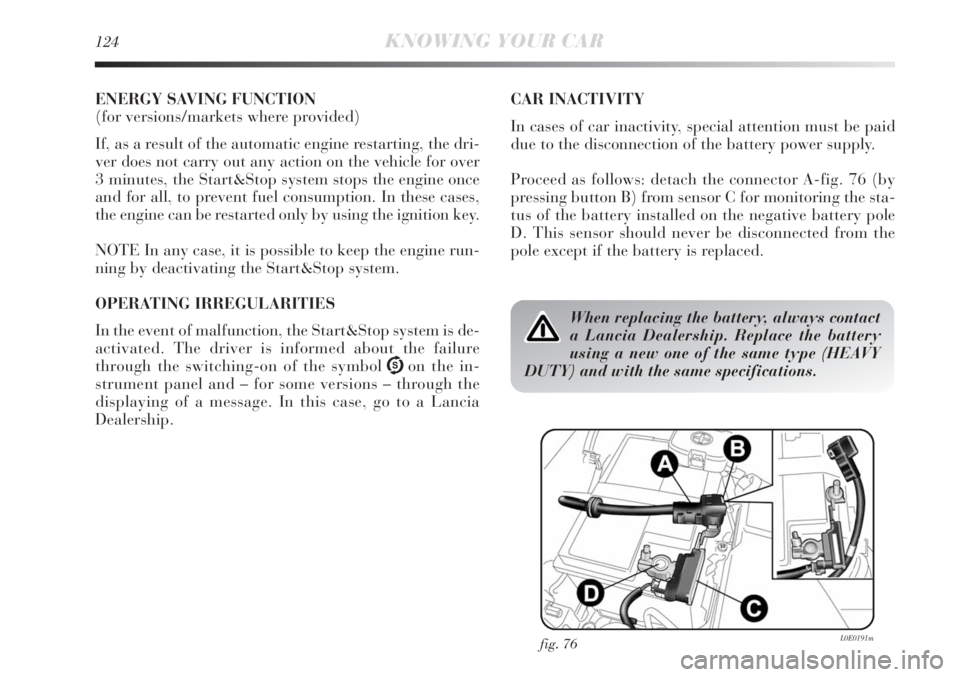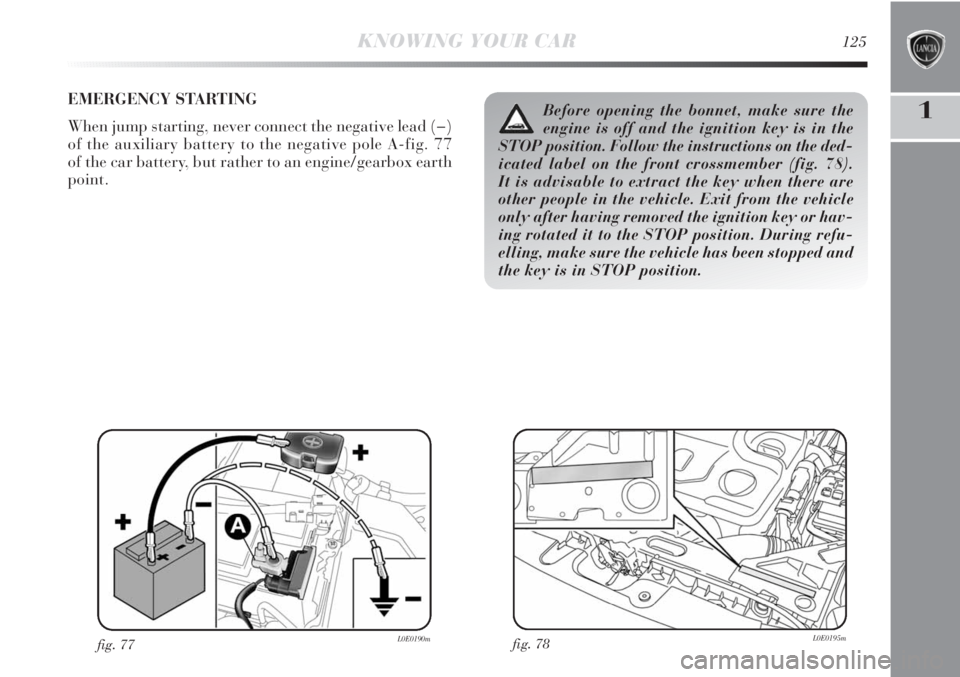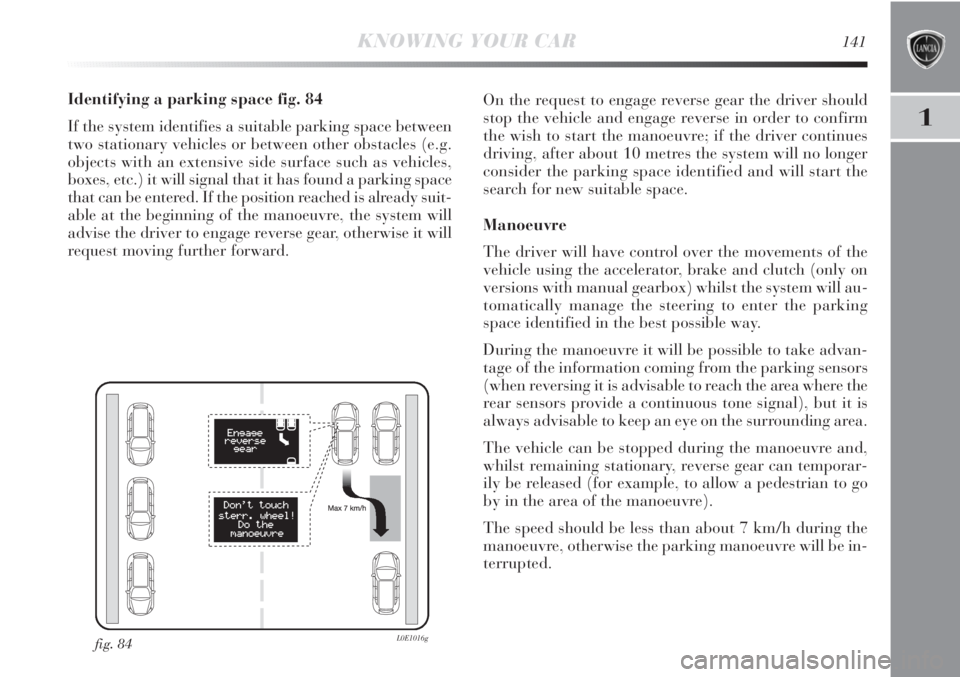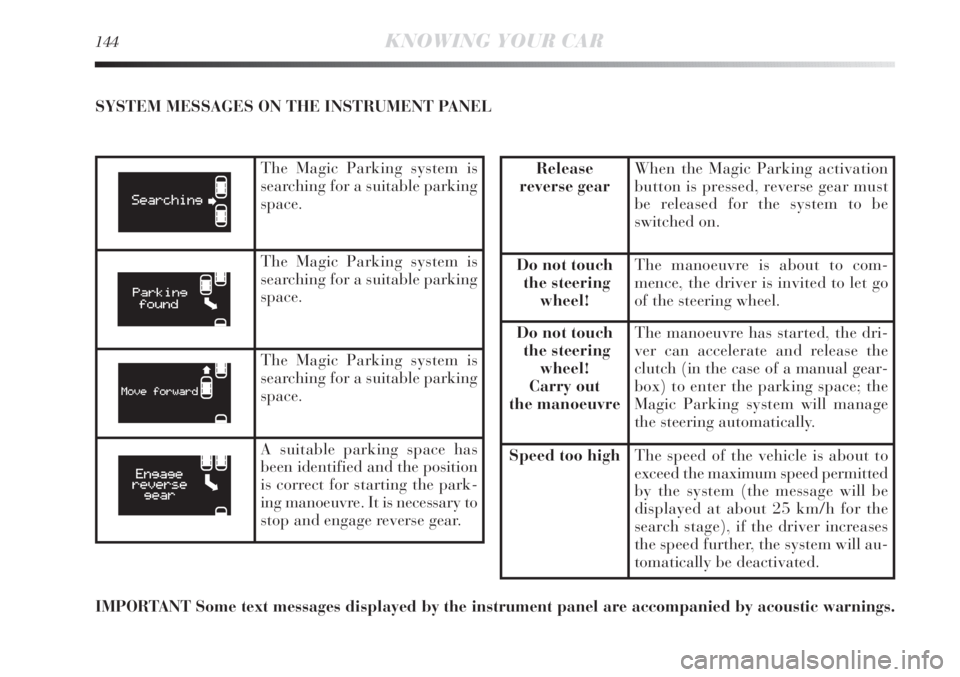stop start Lancia Delta 2013 Owner handbook (in English)
[x] Cancel search | Manufacturer: LANCIA, Model Year: 2013, Model line: Delta, Model: Lancia Delta 2013Pages: 295, PDF Size: 8.29 MB
Page 126 of 295

124KNOWING YOUR CAR
ENERGY SAVING FUNCTION
(for versions/markets where provided)
If, as a result of the automatic engine restarting, the dri-
ver does not carry out any action on the vehicle for over
3 minutes, the Start&Stop system stops the engine once
and for all, to prevent fuel consumption. In these cases,
the engine can be restarted only by using the ignition key.
NOTE In any case, it is possible to keep the engine run-
ning by deactivating the Start&Stop system.
OPERATING IRREGULARITIES
In the event of malfunction, the Start&Stop system is de-
activated. The driver is informed about the failure
through the switching-on of the symbol Uon the in-
strument panel and – for some versions – through the
displaying of a message. In this case, go to a Lancia
Dealership.CAR INACTIVITY
In cases of car inactivity, special attention must be paid
due to the disconnection of the battery power supply.
Proceed as follows: detach the connector A-fig. 76 (by
pressing button B) from sensor C for monitoring the sta-
tus of the battery installed on the negative battery pole
D. This sensor should never be disconnected from the
pole except if the battery is replaced.
fig. 76L0E0191m
When replacing the battery, always contact
a Lancia Dealership. Replace the battery
using a new one of the same type (HEAVY
DUTY) and with the same specifications.
Page 127 of 295

1
KNOWING YOUR CAR125
EMERGENCY STARTING
When jump starting, never connect the negative lead (−)
of the auxiliary battery to the negative pole A-fig. 77
of the car battery, but rather to an engine/gearbox earth
point.
fig. 77L0E0190mfig. 78L0E0195m
Before opening the bonnet, make sure the
engine is off and the ignition key is in the
STOP position. Follow the instructions on the ded-
icated label on the front crossmember (fig. 78).
It is advisable to extract the key when there are
other people in the vehicle. Exit from the vehicle
only after having removed the ignition key or hav-
ing rotated it to the STOP position. During refu-
elling, make sure the vehicle has been stopped and
the key is in STOP position.
Page 130 of 295

128KNOWING YOUR CAR
FAILURE INDICATIONS
Any failure of the electric power steering is indicated by
instrument panel warning light gcoming on together
with a message in the reconfigurable multifunction dis-
play. In the event of electric power steering system fail-
ure, the car can be driven with mechanical steering.
IMPORTANT In some circumstances, factors independent
of the electric power steering could cause the warning light
gon the instrument panel to come on. In this case, stop
the car immediately, switch off the engine for about
20 seconds and then restart the engine. If the gwarn-
ing light remains on, together with the message on the re-
configurable multifunction display, contact a Lancia
Dealership as soon as possible.
Under no circumstances should aftermarket
operations be carried out involving steering
system or steering column modifications
(e.g. installation of anti-theft device). This could
negatively affect performance and safety, invali-
date the warranty, cause serious safety problems
and also result in non-compliance of the car with
type-approval requirements.
On some versions, with the CITY function
activated, the SPORT function is not avail-
able. To activate the SPORT function, deactivate
the CITY function and vice versa, because they are
reciprocally incompatible.
Page 131 of 295

1
KNOWING YOUR CAR129
IMPORTANT The steering may become slightly stiff fol-
lowing parking manoeuvres involving a lot of steering.
This is normal and is caused by a system to prevent the
motor from overheating. No servicing is required. The
power steering system will start working normally again
the next time the car is used.T.P.M.S. SYSTEM
(Tyre Pressure Monitoring System)
(for versions/markets, where provided)
The car may be equipped with a tyre pressure monitor-
ing system. This system comprises a radio frequency
transmitter fitted to each wheel (on the wheel rim inside
the tyre), which is able to send information on the tyre
inflation pressure of each wheel to the control unit.
IMPORTANT NOTES ABOUT THE TPMS SYSTEM
The fault indications are not stored and will therefore
not be displayed after the engine has been switched off
and then on again. If the fault conditions persist, the
control unit will send the relative indications to the in-
strument panel only after the vehicle has been in motion
for a short time.
Before starting any servicing operation, stop
the engine and remove the key from the igni-
tion switch to operate the steering lock, par-
ticularly when the wheels do not touch the ground.
If this is not possible (e.g. if the key must be kept in
the MAR position or the engine must be kept run-
ning), remove the electric power steering system
main fuse.
Page 143 of 295

1
KNOWING YOUR CAR141
Identifying a parking space fig. 84
If the system identifies a suitable parking space between
two stationary vehicles or between other obstacles (e.g.
objects with an extensive side surface such as vehicles,
boxes, etc.) it will signal that it has found a parking space
that can be entered. If the position reached is already suit-
able at the beginning of the manoeuvre, the system will
advise the driver to engage reverse gear, otherwise it will
request moving further forward.On the request to engage reverse gear the driver should
stop the vehicle and engage reverse in order to confirm
the wish to start the manoeuvre; if the driver continues
driving, after about 10 metres the system will no longer
consider the parking space identified and will start the
search for new suitable space.
Manoeuvre
The driver will have control over the movements of the
vehicle using the accelerator, brake and clutch (only on
versions with manual gearbox) whilst the system will au-
tomatically manage the steering to enter the parking
space identified in the best possible way.
During the manoeuvre it will be possible to take advan-
tage of the information coming from the parking sensors
(when reversing it is advisable to reach the area where the
rear sensors provide a continuous tone signal), but it is
always advisable to keep an eye on the surrounding area.
The vehicle can be stopped during the manoeuvre and,
whilst remaining stationary, reverse gear can temporar-
ily be released (for example, to allow a pedestrian to go
by in the area of the manoeuvre).
The speed should be less than about 7 km/h during the
manoeuvre, otherwise the parking manoeuvre will be in-
terrupted.
fig. 84L0E1016g
Page 146 of 295

144KNOWING YOUR CAR
SYSTEM MESSAGES ON THE INSTRUMENT PANEL
The Magic Parking system is
searching for a suitable parking
space.
The Magic Parking system is
searching for a suitable parking
space.
The Magic Parking system is
searching for a suitable parking
space.
A suitable parking space has
been identified and the position
is correct for starting the park-
ing manoeuvre. It is necessary to
stop and engage reverse gear.
Release
reverse gearWhen the Magic Parking activation
button is pressed, reverse gear must
be released for the system to be
switched on.
Do not touch
the steering
wheel!The manoeuvre is about to com-
mence, the driver is invited to let go
of the steering wheel.
Do not touch
the steering
wheel!
Carry out
the manoeuvreThe manoeuvre has started, the dri-
ver can accelerate and release the
clutch (in the case of a manual gear-
box) to enter the parking space; the
Magic Parking system will manage
the steering automatically.
Speed too highThe speed of the vehicle is about to
exceed the maximum speed permitted
by the system (the message will be
displayed at about 25 km/h for the
search stage), if the driver increases
the speed further, the system will au-
tomatically be deactivated.
IMPORTANT Some text messages displayed by the instrument panel are accompanied by acoustic warnings.
Page 149 of 295

1
KNOWING YOUR CAR147
Version with 8 sensors
On the version with 4 front sensors and 4 rear sensors,
the system is activated when reverse gear is engaged or
by pressing the button fig. 87. If there has been a request
to activate the Magic Parking function, the front and rear
sensors are not automatically activated during the search
for a parking space, but can be activated by pressing the
special button (fig. 87) or by engaging reverse gear when
the speed is below around 15 km/h.
When reverse gear is released, the front and rear sensors
remain activated until a speed of around 15 km/h is ex-
ceeded to allow the parking manoeuvre to be completed.
The system can also be activated by pressing the button
fig. 87 in the central panel: a warning light in the but-
ton comes on when the system is activated.The sensors are deactivated by pressing the button again
fig. 87 or when a speed of 15 km/h is exceeded: the
warning light in the button is off when the system is not
active.
When the sensors are activated, the system starts to pro-
duce acoustic signals from the front or rear buzzers as
soon as an obstacle is detected with the frequency in-
creasing as the obstacle gets closer.
When the obstacle is less than about 30 cm away, the
sound becomes continuous. Depending on the position of
the obstacle (in front or behind) the sound is produced
by the corresponding buzzers (front or rear). The obsta-
cle closest to the vehicle is signalled.
The acoustic signal stops immediately if the distance of
the obstacle increases. The sound cycle remains constant
if the distance measured by the centre sensors remains
unchanged, whilst if this situation occurs for the side sen-
sors, the signal is interrupted after about 3 seconds (for
example, to prevent signals in the case of manoeuvres
alongside walls).
fig. 87L0E0249m
The responsibility for parking and other
dangerous manoeuvres always and in every
case lies with the driver. While manoeu-
vring, always make sure that no-one is in the area
concerned (especially children) or animals. The
parking sensors are designed to assist drivers: in
any case, you must always pay the utmost atten-
tion during potentially dangerous manoeuvres,
even when carried out at low speed.
Page 181 of 295

3
STARTING AND DRIVING179
If the engine does not start at the first attempt, return the
ignition key to STOP before repeating the procedure.
If, when the ignition key is turned to MAR, the instru-
ment panel warning light
Yremains on together with
warning light U, turn the key to STOP and then back to
MAR; if the warning light remains on, try the other keys
provided with the vehicle.
Contact a Lancia Dealership if you still cannot start the
engine.
STARTING PROCEDURE FOR DIESEL VERSIONS
Proceed as follows:
❍engage the handbrake;
❍put the gear lever into neutral;
❍turn the ignition key to MAR: the warning lights
mandYon the instrument panel will turn on;
❍wait for the warning lights
Yandmto turn off.
The hotter the engine is, the quicker this will happen;
❍fully depress the clutch pedal without operating the
accelerator;
❍turn the ignition key to AVV as soon as warning light
mgoes out. Waiting too long will waste the work
done by the glow plugs.
Release the key as soon as the engine starts.IMPORTANT With the engine cold, the accelerator pedal
must be fully released when you turn the ignition key to
AV V.
If the engine does not start at the first attempt, return the
ignition key to STOP before repeating the procedure. If
instrument panel warning light
Yremains lit when the
ignition key is turned to MAR, turn the key to STOP and
then back to MAR; if the warning light remains lit, try the
other keys provided with the vehicle. Contact a Lancia
Dealership if you still cannot start the engine.
Warning light mwill flash for 60 seconds
after starting or during prolonged cranking
to indicate a fault with the glow plug heat-
ing system. You can use the car as usual if the en-
gine starts but you should contact a Lancia Deal-
ership as soon as possible.
Page 182 of 295

180STARTING AND DRIVING
Never bump start the engine by pushing,
towing or coasting downhill. This could
cause a flow of fuel into the catalytic con-
verter and damage it beyond repair.
HOW TO WARM UP THE ENGINE
AFTER IT HAS JUST STARTED
Proceed as follows:
❍drive off slowly, letting the engine turn at medium
speed. Do not accelerate abruptly;
❍do not demand maximum performance for the first
few kilometres. Wait until the engine coolant gauge
starts moving.STOPPING THE ENGINE
Turn the ignition key to STOP while the engine is idling.
IMPORTANT After a taxing drive, you should allow the
engine to “catch its breath” before turning it off by let-
ting it idle to allow the temperature in the engine com-
partment to fall.
A quick burst on the accelerator before turn-
ing off the engine serves absolutely no prac-
tical purpose, it wastes fuel and is damag-
ing especially to turbocharged engines.
Page 183 of 295

3
STARTING AND DRIVING181
HANDBRAKE
The handbrake lever is located between the two front
seats.
Pull the lever upwards to operate the handbrake, until
the vehicle is braked.
The car should be braked after a few clicks
of the lever; if it is not, contact a Lancia
Dealership to have it adjusted.
When the handbrake is on and the ignition key is at MAR,
the instrument panel warning light xwill come on.
Proceed as follows to release the handbrake:
❍slightly lift the handbrake and press release button
A-fig. 1;
❍keep button A pressed and lower the lever. The warn-
ing light xon the instrument panel will turn off.
Press the brake pedal when carrying out this operation
to prevent the car from moving accidentally. PARKING THE VEHICLE
Proceed as follows:
❍stop the engine and engage the handbrake;
❍engage a gear (on a slope, engage first gear if the car
is facing uphill or reverse if it is facing downhill) and
leave the wheels steered.
If the car is parked on a steep slope, it is also advisable
to block the wheels with a wedge or stone.
Do not leave the ignition key turned to MAR to prevent
draining the battery. Always remove the key when you
leave the car.
Never leave children in the unattended car. Always re-
move the ignition key when leaving the car and take it
out with you.
fig. 1L0E0072m